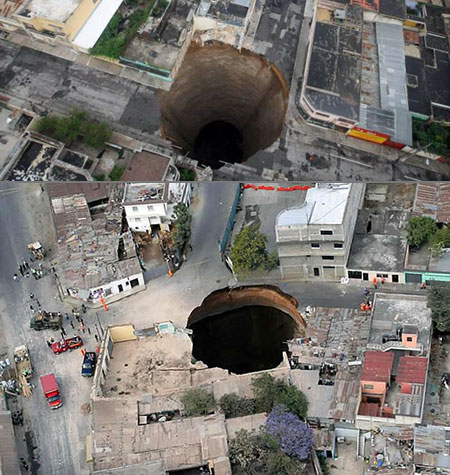
If nothing else, sinkholes are mysterious as they are devastating. Technically speaking, a “sinkhole, also known as a sink, snake hole is a natural depression or hole in the Earth’s surface caused by the chemical dissolution of carbonate rocks.” Continue reading to see five of the world’s deepest sinkholes – bonus videos included.
5. The Devil’s Sinkhole
The Devil’s Sinkhole is a vertical natural bat habitat The 40×60 feet opening drops down to reveal a cavern some 400 feet below. The cavern was first discovered by local residents in 1876. H. S. Barber carved his name inside the cave in 1889. The area was tranferred to the state of Texas in 1985, and open to the public in 1992.
4. Berezniki Sinkhole
In Soviet Russia, the ground moves you. Berezniki’s sinkhole began in 1986 and just grows worse with each passing year. It’s unstoppable. Currently it’s over 200m deep, 80m long and 40m wide. In case you’re thinking “Berezniki”? Who cares? you should know that 10% of the world output of potash comes from this area, and the sinkhole is very close to destroying the mine’s sole rail line.
3. Sarisariñama Sinkholes
The most distinctive features of this tepui are its sinkholes. There are four known sinkholes. Two, Sima Humboldt and Sima Martel, are visually unusual, huge, and well known, with isolated forest ecosystems covering their bottoms. The largest one, Sima Humboldt, is up to 352 metres wide and 314 metres deep. Another Sarisariñama sinkhole, the 1.35 km long Sima de la Lluvia, has been very important for exploration of the processes of erosion on tepuis.
2. Qattara Depression Sinkhole
The vast Qattara west of Cairo, Egypt is the largest natural sinkhole in the world, measuring 80km long by 120km wide. This dangerous, sludge-filled quicksand pit is unearthly in its appearance and shocking in its size. The 133m deep sinkhole has been used in battle and more recently scientists have attempted to develop a $360 million dollar project that would harness the Qattara for complete energy independence. The plan would require digging a ditch from the edge of Qattara to the Mediterranean and allowing the sink to slowly fill with water via a tunnel.
1. Guatemala City Sinkhole
In February 2007, a very large, deep circular hole with vertical walls opened in a poor neighborhood in northeast Guatemala city, killing three people. This hole, which is classified by geologists as either a “piping feature” or “piping pseudokarst”, was 100 metres (330 ft) deep, and apparently was created by fluid from a sewer eroding uncemented volcanic ash and other pyroclastic deposits underlying Guatemala City.
